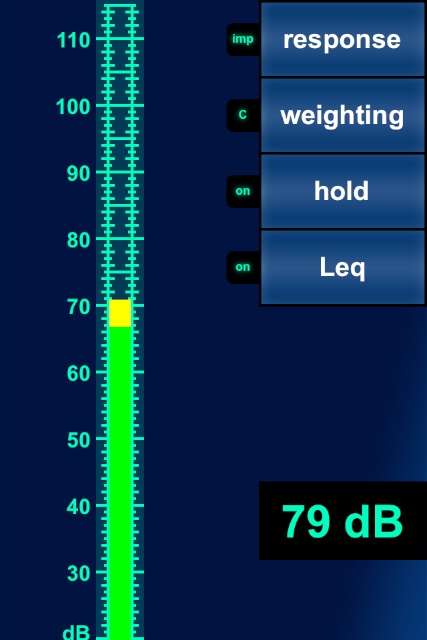Checking Sound Levels with iOS: Failures and Successes

AMITIAE - Tuesday 22 October 2013
|
Checking Sound Levels with iOS: Failures and Successes |
 |
|
|
By Graham K. Rogers
Siemens Decibellmeter Thinking I was on a roll, I tried a third app from Siemens that seemed perfect for the city environment of Bangkok: Siemens Decibellenmeter. Although this uses Dutch as its language, the app is simple enough when first examined, except for one major flaw.
Thinking I was on a roll, I tried a third app from Siemens that seemed perfect for the city environment of Bangkok: Siemens Decibellenmeter. Although this uses Dutch as its language, the app is simple enough when first examined, except for one major flaw.
When the app opened there was a clear screen with three distinct sections below the company name: a panel to display a result; a scale as sound levels rise and fall; and a Start/Stop button. At the bottom are two buttons: the first links to the Siemens Netherlands site, while the second shows a panel with some expected sound levels (e.g. Rockconcert - 110 dB). The first time the Start button is pressed, the user is asked permission for the app to access the microphone. But then nothing happens. There is no movement on the sound scale, nor any recorded figure displayed. I did notice that a red bar appeared at the top of the screen, but this was so fast (and there was no text) that I do not know if this was a good thing or not. I restarted the iPhone, deleted the app, deleted it from iTunes, reinstalled several times; and then I repeated this on the iPad (where it displays in the limited x1 and x2 modes). Into the trash with this one.
dB Volume Not wishing to admit defeat I had a look through iTunes and found a couple of free apps that seemed to serve the same purpose, except that they worked. The first was dB Volume.
Not wishing to admit defeat I had a look through iTunes and found a couple of free apps that seemed to serve the same purpose, except that they worked. The first was dB Volume.
After the nice looking opening screen, the app opens with a straight forward vertical display of sound pressure levels. There are four settings options, each of which affects the display. Beside the vertical bar there is a numerical display of the output. The options are:
The app is simple to use and gives understandable output.
Decibel 10th The third free app I tried is Decibel 10th. The display here is a little more complex as it uses the concept of an analog meter as its main display, but no more difficult to use than dB Volume.
The third free app I tried is Decibel 10th. The display here is a little more complex as it uses the concept of an analog meter as its main display, but no more difficult to use than dB Volume.
There are actually four output methods with this app. At the top is a graph form that runs continuously. When this is pressed, a panel appears with three options: Send data to email, Clear graph, and close. Pressing Clear graph will remove the history. The email arrives with a zipped file that contains data in CSV format (Comma Separated Value). Unfortunately, the zip file did not seem to have any data inside. The main section in the centre of the screen has a simple to read analog display that shows blue for safe levels of sound, and orange for higher levels, beginning around 75 dB. Below this is a digital display with three figures: current (which fluctuates with sound levels), Max, and Peak. Pressing the Max figure allows this to be reset if required. Where the meter needle pivots, there is a button, marked with two yellow bars. When this is pressed, the current figure (meter and numerical) is frozen, so a reading at a specific time can be assessed. Right at the top, there is a display that indicates the type of sound that is being sensed: Quiet Street, Avg Automobile, Loud singing). Also in the top bar is an information (i) icon which allows settings to be changed. This includes a calibration slider.
Graham K. Rogers teaches at the Faculty of Engineering, Mahidol University in Thailand where he is also Assistant Dean. He wrote in the Bangkok Post, Database supplement on IT subjects. For the last seven years of Database he wrote a column on Apple and Macs. |
|

For further information, e-mail to

|

|